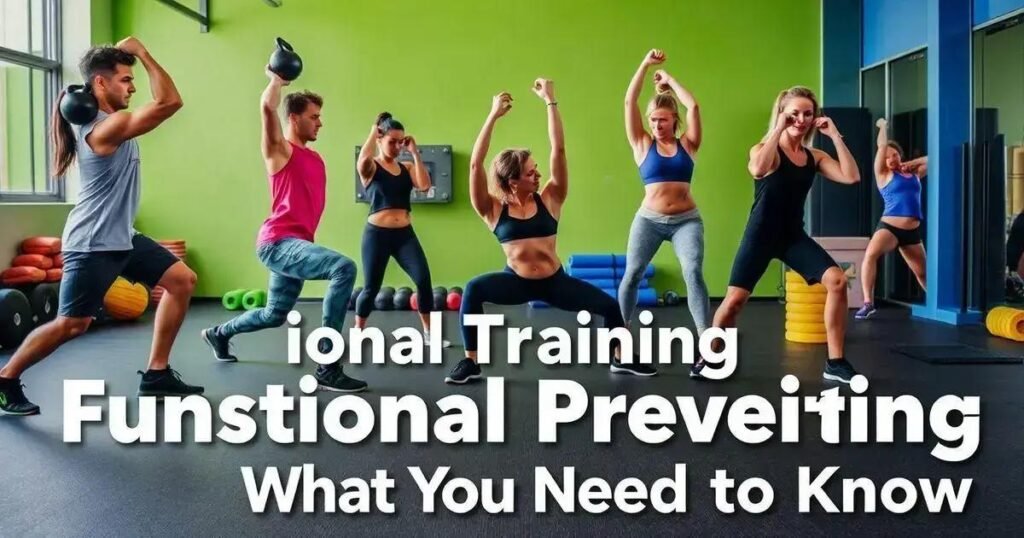Are you tired of feeling stuck in your fitness journey? Do you want to transform your body and unlock your full potential? Look no further than functional training, a workout approach that targets real-life movements and activities to improve overall fitness and athleticism.
By incorporating functional training exercises into your routine, you can expect to see improvements in strength, flexibility, balance, and coordination.
In this post, we’ll delve into the world of functional training, exploring its benefits, exercises, and techniques to help you get started on your fitness journey.
Table of Contents
What is Functional Training?
Functional training is a type of workout that focuses on exercises that mimic real-life movements and activities, such as squats, lunges, and deadlifts. Unlike traditional weightlifting, functional training targets multiple muscle groups at once, promoting overall strength, flexibility, and coordination.
By incorporating functional training exercises into your routine, you can improve your daily functioning, reduce the risk of injury, and enhance your overall athletic performance.
The benefits of functional training are numerous. Not only can it improve your overall fitness and athleticism, but it can also help you build stronger, leaner muscles and increase your endurance. Additionally, functional training can be modified to suit your fitness level, making it accessible to individuals of all ages and abilities.
Whether you’re a beginner or an experienced athlete, functional training can help you achieve your fitness goals and take your performance to the next level.
Incorporating functional training into your workout routine is easier than you think. Start by identifying your fitness goals and assessing your current fitness level. From there, you can create a personalized workout plan that incorporates functional training exercises tailored to your needs.
Begin with beginner-friendly exercises and gradually increase the intensity as you build strength and endurance. Remember to always warm up before your workout and cool down afterwards to prevent injury and reduce muscle soreness.
As a beginner, it’s essential to start with functional training exercises that are easy to learn and execute. Some examples of beginner-friendly exercises include squats, lunges, and deadlifts. These exercises work multiple muscle groups at once, promoting overall strength and coordination.
Start with lighter weights and gradually increase the intensity as you build strength and endurance. Remember to focus on proper form and technique to avoid injury and get the most out of your workout.
Advanced functional training techniques involve more complex exercises that challenge your strength, flexibility, and coordination. Examples of advanced exercises include single-leg squats, burpees, and jump squats.
These exercises require more strength, endurance, and control, making them ideal for experienced athletes looking to take their fitness to the next level. Always warm up before attempting advanced exercises and cool down afterwards to prevent injury and reduce muscle soreness.
Functional training is an effective way to improve your overall fitness and athleticism. By incorporating functional training exercises into your routine, you can build stronger, leaner muscles, increase your endurance, and enhance your overall athletic performance.
Whether you’re a beginner or an experienced athlete, functional training can help you achieve your fitness goals and take your performance to the next level. So why wait? Start incorporating functional training into your workout routine today and experience the benefits for yourself.
Benefits of Functional Training
Functional training is a workout approach that targets real-life movements and activities, promoting overall strength, flexibility, and coordination.
Unlike traditional weightlifting, functional training exercises engage multiple muscle groups at once, reducing the risk of injury and improving daily functioning.
By incorporating functional training into your routine, you can enhance your overall athletic performance, increase endurance, and build stronger, leaner muscles.
The benefits of functional training are numerous.
It can improve overall fitness and athleticism, increase strength and endurance, and reduce the risk of injury.
Additionally, functional training can be modified to suit individual fitness levels, making it accessible to people of all ages and abilities.
Whether you’re a beginner or an experienced athlete, functional training can help you achieve your fitness goals and take your performance to the next level.
Incorporating functional training into your workout routine is easier than you think.
Start by identifying your fitness goals and assessing your current fitness level.
From there, you can create a personalized workout plan that incorporates functional training exercises tailored to your needs.
Begin with beginner-friendly exercises and gradually increase the intensity as you build strength and endurance.
Remember to always warm up before your workout and cool down afterwards to prevent injury and reduce muscle soreness.
Functional training exercises for beginners include squats, lunges, and deadlifts.
These exercises work multiple muscle groups at once, promoting overall strength and coordination.
Start with lighter weights and gradually increase the intensity as you build strength and endurance.
Remember to focus on proper form and technique to avoid injury and get the most out of your workout.
Advanced functional training techniques involve more complex exercises that challenge strength, flexibility, and coordination.
Examples of advanced exercises include single-leg squats, burpees, and jump squats.
These exercises require more strength, endurance, and control, making them ideal for experienced athletes looking to take their fitness to the next level.
Always warm up before attempting advanced exercises and cool down afterwards to prevent injury and reduce muscle soreness.
Functional training is an effective way to improve overall fitness and athleticism.
By incorporating functional training exercises into your routine, you can build stronger, leaner muscles, increase endurance, and enhance overall athletic performance.
Whether you’re a beginner or an experienced athlete, functional training can help you achieve your fitness goals and take your performance to the next level.
How to Incorporate Functional Training into Your Workout
To incorporate functional training into your workout, start by identifying your fitness goals and assessing your current fitness level.
From there, you can create a personalized workout plan that incorporates functional training exercises tailored to your needs.
Begin with beginner-friendly exercises and gradually increase the intensity as you build strength and endurance.
Remember to always warm up before your workout and cool down afterwards to prevent injury and reduce muscle soreness.
You can also mix and match exercises from different categories to keep your workouts interesting and challenging.
Consider Professional Guidance
Additionally, consider working with a personal trainer or fitness coach to help you develop a functional training plan that suits your needs and goals.
Functional Training Exercises for Beginners
For beginners, functional training exercises can be intimidating, but with the right guidance, you can start seeing results quickly.
One of the most effective exercises for beginners is the squat, which works multiple muscle groups at once. Start with a weight that feels comfortable and gradually increase the intensity as you build strength.
Another great exercise for beginners is the lunge, which targets the legs and glutes. Remember to keep your back straight and engage your core to maintain proper form.
Additionally, consider incorporating exercises that work multiple muscle groups at once, such as the deadlift or bench press. These exercises can help you build strength and endurance quickly and efficiently.
Advanced Functional Training Techniques
Advanced functional training techniques involve more complex exercises that challenge strength, flexibility, and coordination.
One example is the single-leg squat, which requires balance and control to perform. Another example is the burpee, which is a full-body exercise that involves a squat, push-up, and jump.
These exercises can help improve overall athleticism and functional fitness. Additionally, consider incorporating plyometric exercises, such as jump squats and box jumps, to improve power and explosiveness.
Remember to always warm up before attempting advanced exercises and cool down afterwards to prevent injury and reduce muscle soreness.
Conclusion: Take Your Fitness to the Next Level
Now that you’ve learned the benefits of functional training and how to incorporate it into your workout, it’s time to take your fitness to the next level. Remember to start slow and gradually increase the intensity and difficulty of your workouts. Listen to your body and rest when needed, and don’t be afraid to try new exercises and techniques.
With consistency and dedication, you can achieve your fitness goals and enjoy the many benefits that functional training has to offer. Whether you’re looking to improve your overall health, increase your strength and endurance, or simply feel more confident and capable, functional training can help you achieve your goals.
So why wait? Get started today and take your fitness to the next level!
Frequently Asked Questions about Artificial Intelligence for Micro Enterprises
How can task automation benefit my micro business?
Task automation frees up your team from repetitive tasks, increasing productivity and allowing them to focus on more strategic tasks.
What tools can I use for data analysis?
There are many tools available, such as Google Analytics, Tableau, and Microsoft Power BI, that help collect and interpret valuable data.
What are chatbots and how do they improve customer service?
Chatbots are virtual assistants that can answer questions and resolve problems at any time, improving the customer experience and freeing up your team.
How can I personalize the customer experience?
Through data analysis, you can better understand customer preferences and offer personalized recommendations and promotions.
Why is customer feedback important?
Feedback is essential to identify areas that need improvement and adjust your service strategy to ensure customer satisfaction.
Is artificial intelligence accessible to micro businesses?
Yes, there are many AI solutions that are accessible and scalable, allowing micro businesses to implement them to improve efficiency and customer service.



